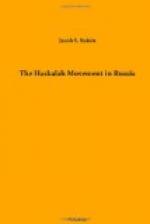[Footnote 7: FKN, pp. 126-132; Voskhod, 1893; on the Hasidim and Mitnaggedim see below.]
[Footnote 8: Ma’aseh Tobiah, p. 18; Meassef, pp. 206-209; Geiger (Melo Hofnayim, Berlin, 1840, pp. 1-29) published Delmedigo’s corroboration of this statement.]
[Footnote 9: Rapoport, Etan ha-’Ezrahi, Ostrog, 1776, Introduction.]
[Footnote 10: Cf. Zederbaum, Keter Kehunnah, pp. 72-74, 84, 121, etc., and Ha-Shiloah, xxi. 165; Schechter, Studies in Judaism, i., Philadelphia, 1896, i. 17 f., and Greenstone, The Messiah Idea in Jewish History, pp. 237 f. According to some, Judah he-Hasid and his followers went to Palestine in the expectation, not of the Messiah, but of Shabbatai Zebi, who was believed to have been in hiding for forty years, in imitation of the retirement of Moses in Midian for a similar period of years. “The ruins of Rabbi Judah he-Hasid’s synagogue” and Yeshibah in Jerusalem still keep the memory of the event fresh in the minds of Palestinian Jews.]
[Footnote 11: Among the many wonderful episodes in the life of the master, his biographer mentions also that he could swallow down the largest gobletful in a single gulp (Shibhe ha-Besht, Berdichev, 1815, pp. 7-8). The best, though not an impartial work on Hasidism is Zweifel’s Shalom ’al Yisrael, 4 vols., Zhitomir, 1868-1872.]
[Footnote 12: Ha-Boker Or, iv. 103-105: [Hebrew: H’fkormot Mn Nshmot M’lh Hngon.]]
[Footnote 13: Cf. Emden, op. cit., p. 185, and Shimush, Amsterdam, 1785, pp. 78-80, with Pardes, ii. 204-214.]
[Footnote 14: See Schechter, op. cit., pp. 73-93; Silber, Elijah Gaon, 1906; Levin, ’Aliyat Eliyahu, Vilna, 1856, and FKN, pp. 133-155.]
[Footnote 15: Levin, op. cit., pp. 28-30.]
[Footnote 16: See Ha-Bikkurim, i. 1-26; ii. 1-20; Ha-Zeman (monthly), 1903, ii. 6; Plungian, Ben Porat, Vilna, 1858, p. 33; Keneset Yisrael, iii. 152 seq.]
[Footnote 17: Sirkes (Bayit Hadash, Cracow, 1631, p. 40) decides that Jews may employ in their synagogue melodies used in the church, since “music is neither Jewish nor Christian, but is governed by universal laws.” See also Hayyim ben Bezalel’s Wikkuah Mayim Hayyim, Introduction, and passim.]
[Footnote 18: See J.S. Raisin, Sect, Creed and Custom in Judaism, Philadelphia, 1907, p. 9, and ch. viii.; Ha-Meliz, x. 186, 192-194.]
[Footnote 19: See Ha-Zeman (monthly), 1903, ii. 7.; Shklov, Euclidus, Introduction; Keneset Yisrael, 1887, and Hagra on Orah Hayyim, Shklov, 1803, Introduction.]
[Footnote 20: See Graetz, op. cit, xi. 590, 604, 606. The Gaon, who as a rule was very mild, lost patience with the Hasidim and wielded the weapons of the kuni (or stocks and exposures) and excommunication without mercy. The Hasidim were also accused of being not only religious dissenters but revolutionaries. Zeitlin, quoted in Yiddishes Tageblatt, from the Moment, March, 1913.]
[Footnote 21: See Karpeles, Time of Mendelssohn, p. 297; Kayserling, Mendelssohn, p. 12; Ha-Meliz, 1900, nos. 194-196.]




